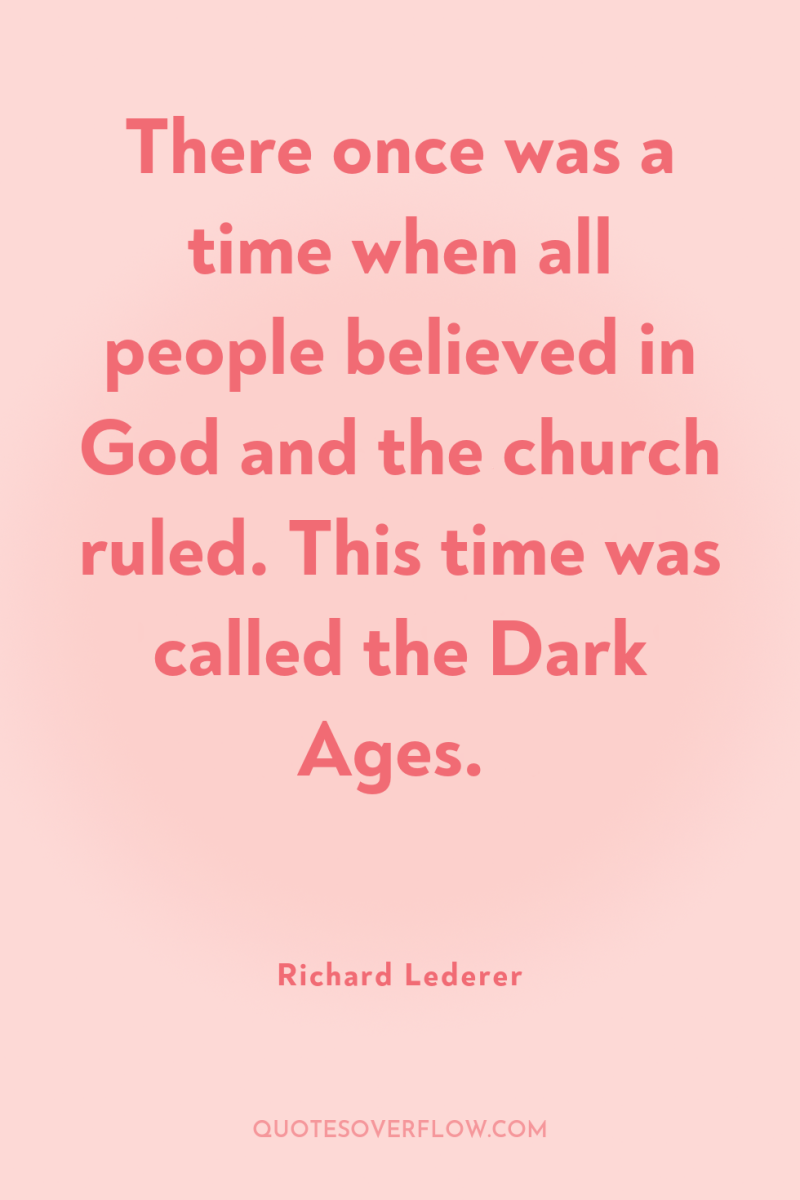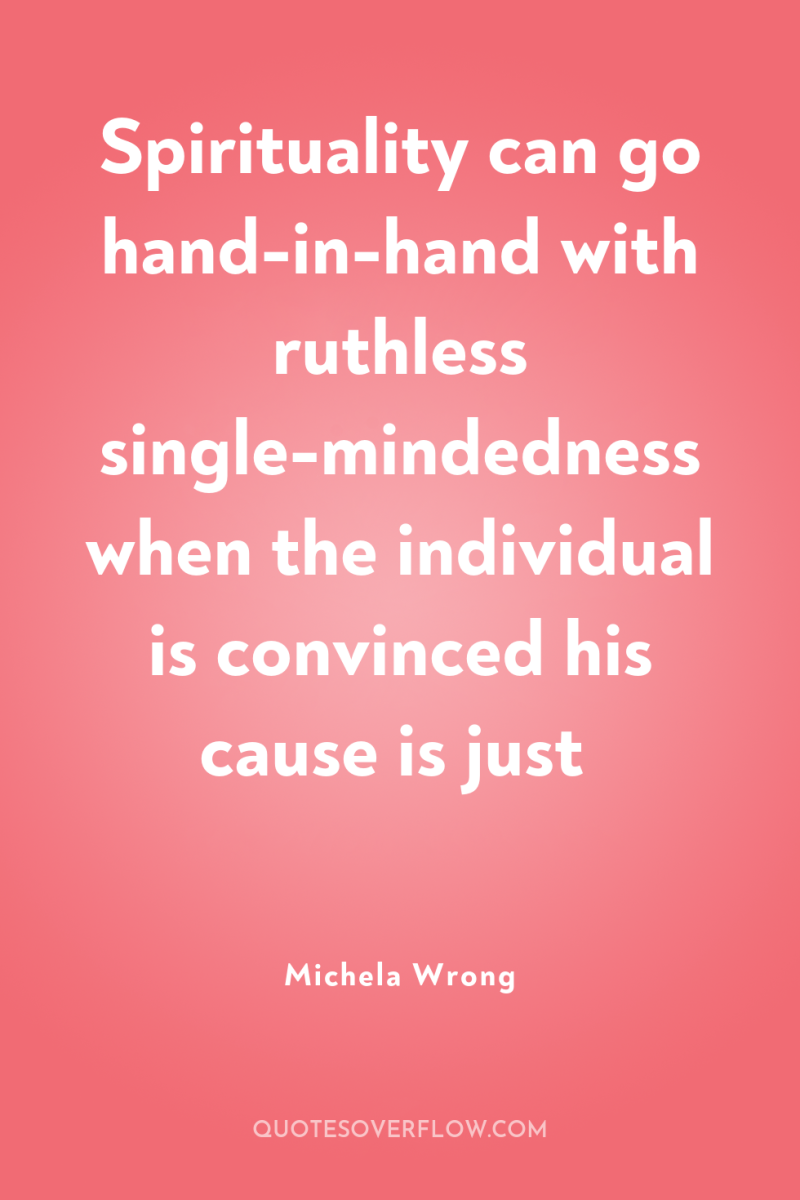1
In the Middle Ages, cathedrals and convents burned like tinder; imagining a medieval story without a fire is like imagining a World War II movie in the Pacific without a fighter plane shot down in flames.Umberto Eco

2
There once was a time when all people believed in God and the church ruled. This time was called the Dark Ages.Richard Lederer

3
Spirituality can go hand-in-hand with ruthless single-mindedness when the individual is convinced his cause is justMichela Wrong
4
Those darling byegone times, Mr Carker, ' said Cleopatra, 'with their delicious fortresses, and their dear old dungeons, and their delightful places of torture, and their romantic vengeances, and their picturesque assaults and sieges, and everything that makes life truly charming! How dreadfully we have degenerated!Charles Dickens
5
...Prophecy is like a treacherous woman. She takes your member in her mouth, and you moan with the pleasure of it and think, how sweet, how fine, how good this is... and then her teeth snap shut and your moans turn to screams... Prophecy will bite your prick off everytime,George R.r. Martin
6
Those who like to interpret historical facts symbolically may recognize in this the spirit of a specifically "modern" conception of the world which permits the subject to assert itself against the object as something independent and equal; whereas classical antiquity did not as yet permit the explicit formulation of this contrast; and whereas the Middle Ages believed the subject as well as the object to be submerged in a higher unity.Erwin Panofsky
7
What I want to know is, in the Middle Ages, did they do anything for Housemaid's Knee? What did they put in their hot baths after jousting?H.G. Wells
8
We refer to the Middle Ages as ages of faith; a time in which men believed a heavenly Jerusalem above the sky much as they believed an earthly Sion beyond the sea; when the whole of their thought was of a piece with their theology..those were days when a thoughtful soul here or there could realize some unity of mental vision. The fact should be admitted, however we regard it - whether as the stultifying tyranny of dogma or as an enviable single-mindedness; an ideal too easily realized, no doubt, in a plentiful dearth of empirical knowledge, and yet establishing a standard after which perplexed modernity may strive.Jocelyn Gibb
9
The day will come when you need them to respect you, even fear you a little. Laughter is poison to fear.George R.r. Martin
10
The Greeks made Space the subject-matter of a science of supreme simplicity and certainty. Out of it grew, in the mind of classical antiquity, the idea of pure science. Geometry became one of the most powerful expressions of that sovereignty of the intellect that inspired the thought of those times. At a later epoch, when the intellectual despotism of the Church, which had been maintained through the Middle Ages, had crumbled, and a wave of scepticism threatened to sweep away all that had seemed most fixed, those who believed in Truth clung to Geometry as to a rock, and it was the highest ideal of every scientist to carry on his science 'more geometrico. .Hermann Weyl
11
The more formidable the contradiction between inexhaustible life-joy and inevitable fate, the greater the longing which reveals itself in the kingdom of poetry and in the self-created world of dreams hopes to banish the dark power of reality. The gods enjoy eternal youth, and the search for the means of securing it was one of the occupations of the heroes of mythology and the sages, as it was of real adventurers in the middle ages and more recent times. But the fountain of youth has not been found, and can not be found if it is sought in any particular spot on the earth. Yet it is no fable, no dream-picture; it requires no adept to find it: it streams forth inexhaustible in all living nature.Ferdinand Cohn
12
The hard truths are the ones to hold tight. - Old BearGeorge R.r. Martin
13
Magic begins in superstition, and ends in science.... At every step the history of civilization teaches us how slight and superficial a structure civilization is, and how precariously it is poised upon the apex of a never-extinct volcano of poor and oppressed barbarism, superstition and ignorance. Modernity is a cap superimposed upon the Middle Ages, which always remain.Will Durant
14
Here is the tragedy of theology in its distilled essence: The employment of high-powered human intellect, of genius, of profoundly rigorous logical deduction–studying nothing. In the Middle Ages, the great minds capable of transforming the world did not study the world; and so, for most of a millennium, as human beings screamed in agony–decaying from starvation, eaten by leprosy and plague, dying in droves in their twenties–the men of the mind, who could have provided their earthly salvation, abandoned them for otherworldly fantasies.Andrew Bernstein
15
The rising influence of lay piety is particularly marked upon the Mariological controversies of the late medieval period. Two rival positions developed: the maculist position, which held that Mary was subject to original sin, in common with every other human being; and the immaculist position, which held that contrary view that Mary was in some way preserved from original sin, and was thus to be considered sinless. The maculist position was regarded as firmly established within the High Scholasticism of the thirteenth century. The veneration of the Virgin within popular piety, however, proved to have an enormously creative power that initially challenged, and subsequently triumphed over, the academic objections raised against it by university theologians. .Unknown
16
It is certain that the labors of these early workers in the field of natural knowledge were brought to a standstill by the decay and disruption of the Roman Empire, the consequent disorganisation of society, and the diversion of men's thoughts from sublunary matters to the problems of the supernatural world suggested by Christian dogma in the Middle Ages. And, notwithstanding sporadic attempts to recall men to the investigation of nature, here and there, it was not until the fifteenth and sixteenth centuries that physical science made a new start, founding itself, at first, altogether upon that which had been done by the Greeks. Indeed, it must be admitted that the men of the Renaissance, though standing on the shoulders of the old philosophers, were a long time before they saw as much as their forerunners had done.Thomas Henry Huxley
17
In the early twelfth century century the Virgin had been the supreme protectress of civilisation. She had taught a race of tough and ruthless barbarians the virtues of tenderness and compassion. The great cathedrals of the Middle Ages were her dwelling places upon earth. In the Renaissance, while remaining the Queen of Heaven, she became also the human mother in whom everyone could recognise qualities of warmth and love and approachability.. The stabilising, comprehensive religions of the world, the religions which penetrate to every part of a man's being--in Egypt, India or China--gave the female principle of creation at least as much importance as the male, and wouldn't have taken seriously a philosophy that failed to include them both.. It's a curious fact that theall-male religions have produced no religious imagery--in most cases have positively forbidden it. The great religious art of the world is deeply involved with the female principle. .Kenneth Clark